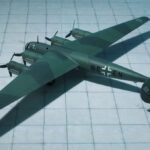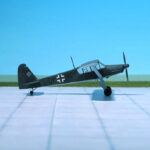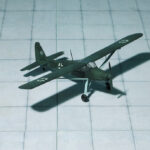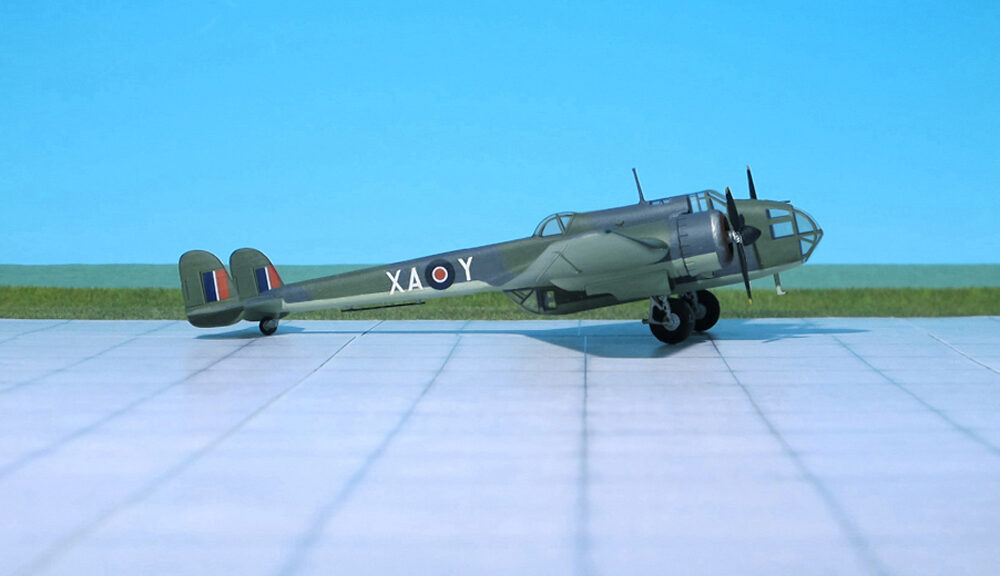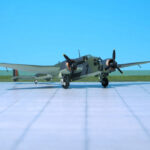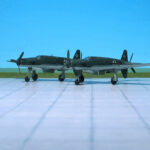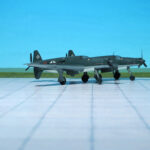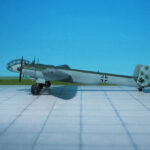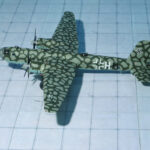TYPE: Strategic bomber, long-range maritime reconnaissance aircraft
ACCOMMODATION: Crew of eight
POWER PLANT: Four Junkers Jumo 211J inline engines, rated at 1340 hp each or four BMW 801G radial engines, rated at 1,750 hp each.
PERFORMANCE: 339 mph at 36,000 kg at 20,015 ft
COMMENT: The Messerschmitt Me 264 was a long-range strategic bomber developed during World War II for the German Luftwaffe as its main strategic bomber. The design was later selected as Messerschmitt‘s competitor in the RLM (Reichsluftfahrt-ministerium, German Air Ministry) Amerikabomber programme, for a strategic bomber capable of attacking New York City from bases in France or the Azores.
Three prototypes were built but production was abandoned to allow Messerschmitt to concentrate on fighter production and the Junkers Ju 390 was selected in its place. Development continued as a maritime reconnaissance aircraft instead.
The origin of the Me 264 design came from Messerschmitt’s long-rangereconnaissance aircraft project, the P.1061, of the late 1930s. A variant on the P.1061 was the P.1062 of which three prototypes were built, with only two “engines” to the P.1061’s four, but they were, in fact, the more powerful Daimler-Benz DB 606 “power systems”, each comprising a pair of DB 601 inverted V-12 engines. These were also successfully used in the long-range Messerschmitt Me 261, itself originating as the Messerschmitt P.1064 design of 1937. The DB 606’s later use in the Heinkel He 177A‘s airframe design resulted in derision by Reichsmarschall Hermann Göring as „welded-togehter engines in August 1942, due to badly designed engine installations. In early 1941, six P.1061 prototypes were ordered from Messerschmitt, under the designation Messerschmitt Me 264. This was later reduced to three prototypes.
The progress of these projects was initially slow, but after Germany had declared war on the United States four days after the Pearl Harbor attack by Imperial Japan, the Reichsluftfahrtministerium started the more serious Amerikabomberprogramme in the spring of 1942 for a very long range bomber, with the result that a larger, six-engine aircraft with a greater bomb load was called for. Proposals were put forward for the Junkers Ju 390, the Focke-Wulff Ta 400, a redesign of the unfinalized and unbuilt Heinkel He 277 design, and a design study for an extended-wingspan six-engine Messerschmitt Me 264B. The need for six engines was prompted by the ongoing inability of Germany’s aviation powerplant designers to create combat-reliable powerplants of 2,000 PS and above power output levels, thwarting efforts to do the same with just four engines instead. As the similarly six-engined Junkers Ju 390 could use components already in use for the Junkers Ju 290 this design was chosen.
The Me 264 was not abandoned, however, as the Kriegsmarine (German Navy) separately demanded a long-range maritime patrol and attack aircraft to replace the converted Focke-Wulf Fw 200 Condor in this role. As a result, the two pending prototypes were ordered to be completed as development prototypes for the Me 264A ultra long-range reconnaissance aircraft.
The Me 264 was an all-metal, high-wing, four-engine heavy bomber of classic construction. The fuselage was round in cross-section and had a cabin in a glazed nose, comprising a “stepless cockpit” with no separate windscreen section for the pilots, which was common for most later German bomber designs. A strikingly similar design was used for the Boeing B-29 Superfortress, of slightly earlier origin. The wing had a slightly swept leading edge and a straight trailing edge. The empennage had double tail fins. The undercarriage was a retractable tricycle gear with large-diameter wheels on the wing-mounted main gear. . In order to provide comfort on the proposed long-range missions, the Me 264 featured bunk beds and a small galley complete with hot plates.
The Me 264’s first prototype was originally fitted with four Junkers Jumo inverted V12 engines using the then-new Kraftei (or “power egg”) unitized powerplant installation as standardized for the earlier Junkers Ju 88A Schnellbomber, but inadequate power from the Jumo 211 engines led to their replacement on the Me 264 V1 first prototype with four similarly unitized 1,700 hp BMW 801G engines. The first prototype, the Me 264 V1, bearing the Stammkennzeichen factory code of RE+EN, was flown on 23 December 1942. It was powered at first by four Junkers Jumo 211J inline engines of 1,340 hp each. In late 1943, these were changed to the BMW 801G radial engines which delivered 1,750 hp each.
Trials showed numerous minor faults and handling was found to be difficult. One of the drawbacks was the very high wing loading of the Me 264 in fully loaded conditions at some 356 kg/m2. Comparable aircraft, such as the Boeing B-29 Superfortress with a wing loading of 337 kg/m2, the redesigned Heinkell He 277 at 334.6 kg/m2 and the Junkers Ju 390 at 209 kg/m2 had lower wing loadings. The relatively high wing loading caused poor climb performance, loss of manoeuvrability, stability and high take-off and landing speeds. The first prototype was not fitted with weapons or armour but the following two prototypes, the Me 264 V2 and V3 had armour for the engines, crew and gun positions. The Messerschmitt Me 264 V2 was built without defensive armament and vital equipment and the Me 264 V3 was to be armed and have the same armour.
In 1943, the Kriegsmarine withdrew their interest in the Me 264 in favour of the Ju 290 and the planned Ju 390. The Luftwaffe indicated preference for the unbuilt Focke Wulf Ta 400 and the Heinkel 277 as Amerikabomber candidates in May 1943, based on their performance estimates. Further payments for development work to Messerschmitt AG for its design were stopped. Late in 1943, the second prototype, Messerschmitt Me 264 V2, was destroyed in a bombing attack. On 18 July 1944, the first prototype, which had entered service with Transportstaffel 5, was damaged during an Allied bombing bombing raid and was not repaired. The third prototype, which was unfinished, was destroyed during the same raid. In October 1943, further Me 264 development was stopped to concentrate on the development and production of the Messerschmitt Me 262 turbojet fighter-bomber.
Following the cancellation of the competing He 277 in April 1944, on 23 September 1944, work on the Me 264 project was officially cancelled. Messerschmitt proposed a six-engine version of the Me 264, the Me 264/6m (or alternately Me 364), but it was never built (Ref.: 24).







